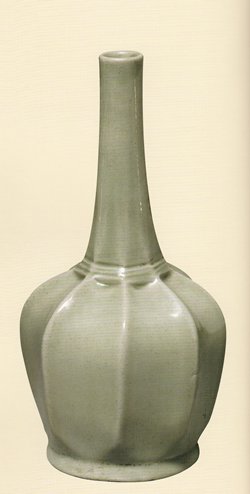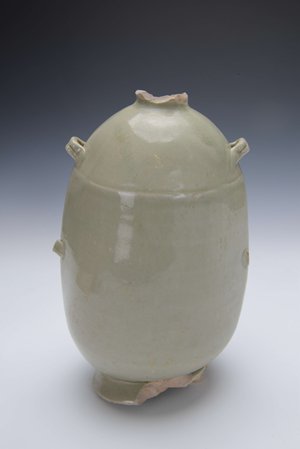
An octagon vase discovered at Famen Temple (Photo/Courtesy of the Palace Museum)

A pot from the Housiao Kiln (Photo/Courtesy of the Palace Museum)
During the Tang Dynasty (618-907), a particular type of ceramic ware possessed a color that was so unique that it was immortalized in poetry. Known as mise - or secret color - wares, these ceramics were exclusively made for the imperial family and so were rarely seen by outsiders. Records of these wares dropped off during the Song Dynasty (960-1279) so it wasn't until 1987, when several of these wares were discovered buried at Famen Temple in North China's Shanxi Province, that people once again got to see what the color of these secret color wares looked like.
Now visitors to the Palace Museum will have the chance to see these mysterious wares for themselves as nearly 200 secret color wares from the late Tang Dynasty to early Song Dynasty are currently on display at the museum until July 2.
Archaeological Discoveries and Re-entering the Palace of Secret Color Wares gathers examples of secret color wares discovered at kiln sites in East China's Zhejiang Province, the dig site at Famen Temple and in tombs of nobles who lived in various states such as the State of Wuyue (907-978).
Origins
Prior to the Famen Temple discovery, the appearance of these secret color wares were commonly known through Tang Dynasty poet Lu Guimeng's poem "Secret Color Yue Ware," in which he described them as being a "bluish-green."
Looking at the secret color wares discovered at various sites, we now know that these wares are mostly cyan. It's not only the color that set these wares apart, their quality is also a step above other wares of the time in that they tend to be smooth, have fewer and smaller pores and lack the large amount of impurities of ordinary ceramic wares. The even and pure glaze used in their production causes secret color bowls to seem as if they are filled with water if looked at from a distance.
Just as companies are very protective of their intellectual property today, in ancient times ceramic makers were very protective of their trade secrets. The Yue kiln where these secret color wares were made was no exception. The formula for the glaze used in production was a highly kept secret.
In addition to this, the wares were also meant for royalty and were not allowed to be used by common folk. This led to them becoming known as "secret color" wares.
For a long time, experts believed that secret color wares were just a name that people used for all green ceramic wares, or celadon wares, made for royal families.
This changed in 1987, when an earthquake rocked Famen Temple, leaving half of the temple in ruins.
During restoration efforts, workers discovered a basement under the temple which contained 14 pieces of fine ceramic wares as well as a large amount of valuable relics from the Tang Dynasty.
Examining the ceramics, experts discovered that they were different from most celadon wares from that period in both appearance and chemical composition of the glaze. Realizing that these wares matched depictions in historical literature, these experts identified them as being the long mysterious "secret color" wares.
Important clue
The Famen Temple discovery provided a valuable clue for identifying secret color wares discovered elsewhere.
To date, secret color wares have mainly been found in sites related to ancient China's noble class, which reaffirms that these wares were made for royalty. For example, these ceramics were found in the mausoleum of Empress Yuande, the wife of the second emperor of the Song Dynasty, Emperor Taizong.
The discovery in Famen Temple also helped narrow down where these wares were made. For a long time, experts knew that these wares were made in the Shanglinhu region of Cixi in Zhejiang Province, but due to the sheer amount of kiln sites in the area they were unable to pinpoint from which kiln secret color wares originated.
Fortunately, from 2015 to 2017 archeologists discovered a great deal of ceramic wares at the Housiao Kiln site that matched the secret color wares found at Famen Temple. This proved that the kiln was one of the production sites for this royal ware.
This discovery was so important that it was later listed as one of the top 10 archaeology discoveries in China for 2016.


















































